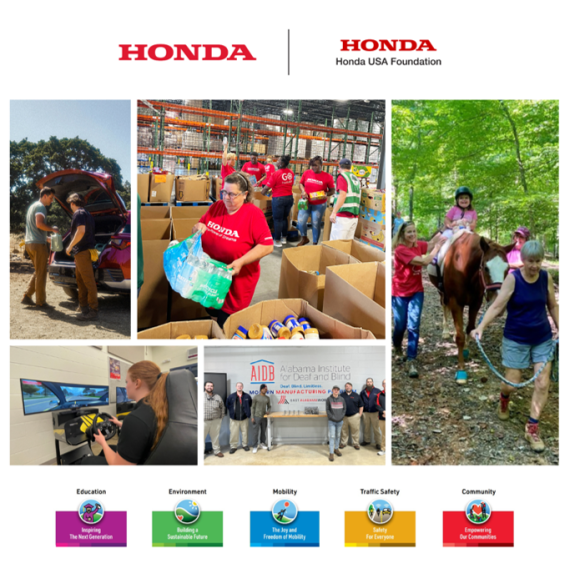Winning Races …. With Rubber Bands
Associates at Honda R&D Americas and students at Los Angeles’s ArtCenter College of Design have taken alternative energy for vehicles to a whole new level. They’re not using vegetable oil, hydrogen, or batteries but, rather, rubber bands. And in doing so, they’re finding winning formulas for approaching everyday work.
Every year, the ArtCenter hosts its “Formula-E Race.” The “E” stands for “Elastic.” In the 14 weeks leading up to the event, student and corporate teams strategize on how they can win a drag race, hill climb, and figure-eight race by building mini fabricated cars with, among other materials, the required 16 feet of rubber band.
The competition involves thinking about everything from aerodynamics and torque to durability and speed, and this past summer, Honda’s LR1 team was up to the challenge.
“It is incredible to see how the participants all work together by tackling different aspects of the vehicles,” Honda’s Randall Smock, a Senior Exterior Designer and the project leader for Honda’s team in the competition, said. “Some want to reinvent suspension, some are all about maximizing efficiency of power or weight, while some want to experiment with how to use the rubber bands.”
Participating for a third time in this annual event, Honda associates from LR1 fielded two remote-controlled vehicles in the Pro Class Tournament: VTEC (Variable Tension Elastic Control) and E-TWIN. Smock, along with Nik Bjazevic, Curtis Strawn, Josh Kim, Joe Park, James Robbins, John Frye, Pete Petersen, Walter Ma, Matthew Mantz, Dale Ogami, Bernard Sally, Stephanie Ishitani, Socorro Miramontes, and Yuyol Lee made up the team.
Smock served as a general liaison between Honda and the ArtCenter for the “Formula-E” and is one of the many designers at HRA-L that graduated from the school and still teaches there part time.
“Our participation in Formula-E is all part of Honda’s greater concept of community involvement called the ‘Dream Cycle,’” Smock said. “The three elements are ‘Spark the Dream,’ in which we educate and expose people to the world of industrial design and Honda; ‘Fuel the Dream,’ by supporting and enabling those who are pursuing their own dreams; and ‘Live the Dream,’ by interacting in common interests and sharing in each other’s passions.”
LR1’s engagement with Formula-E is part of Live the Dream, in that the Honda team is not only competing, but they are also sharing and learning from one another as well as the students.
“And the students are awesome,” noted Strawn, an LR1 Budget Controller and designer, engineer, and fabricator for the E-TWIN with Bjazevic.
“Their attention to detail is off the charts,” Bjazevic added. “Our car had a few unique design features that we didn’t think anyone would notice, but after the first run, several students asked about them. As we talked, you could just see the gears in their heads turning.”
Honda associates know this education experience firsthand from their own days as students at the ArtCenter.
“I first competed in the Formula-E back in 1986, when I was a student at the ArtCenter,” said Petersen, SDQ Data Assistant Manager and team design advisor. “And my team actually won. Of course, the rules were a bit different then, and the course was nothing like it was this year. But it has always been such a great team-building activity.”
In noting Honda’s “rich history” in racing, Petersen emphasized how Formula-E uniquely “brings out the best in its team members,” because of its structure and requirements to innovate – something Smock echoed.
“The coolest part to watch, though, are those who intentionally step back and try to boldly take a whole new perspective on the challenge at hand, leading to unorthodox solutions,” he said. “Although some of the ideas may fail, I love to see the creativity flowing.”
Strawn admitted that the Honda team had a failure or two of their own with their first prototype, but “it is important to remember that if you want to create something that is truly new and innovative, failure is part of the process. This definitely applies when we create a new, successful Honda product.”
And it certainly applied to the Honda products they created for Formula-E. Even though the team had almost no test time prior to the event and had limited time to work on the vehicles’ development, E-TWIN was able to secure the fastest time in the Sculpture Gard Flats run at 18.50 seconds, successfully breaking the previous record of 19.33 seconds.
“Formula-E reminds me that we need to stay passionate about what we’re doing in the styling studio,” Smock said, “so that we continually move forward and not rely completely on any standard formula to a solution.”
It’s such thinking that shows how associates—whether it’s in making Honda a company that society wants to exist or winning top races through their challenging spirit—know how to make the rubber (band) hit the road.

